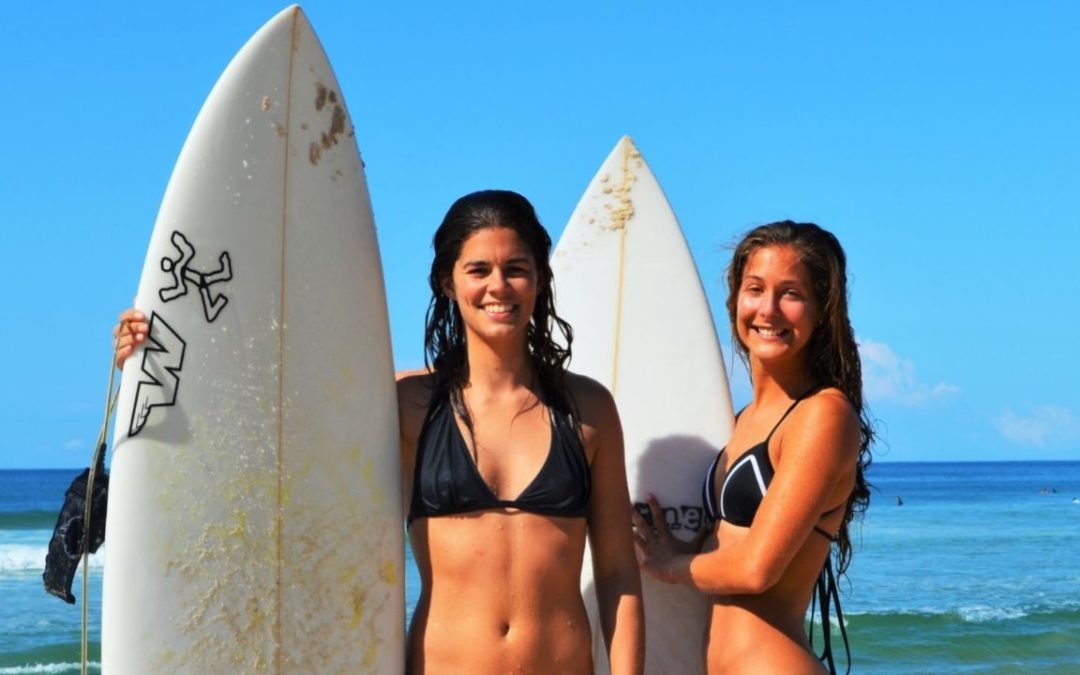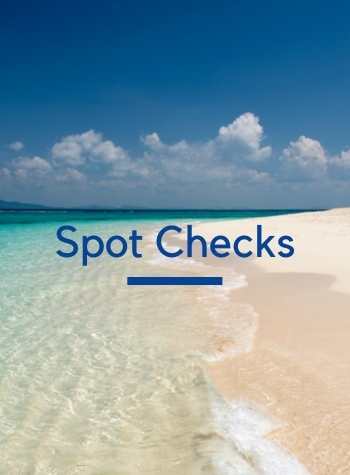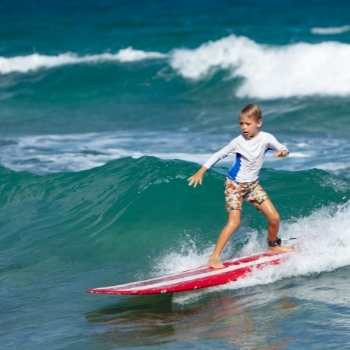Planning to start off your surf career on a 7 foot surfboard? Wow, hold up. Can you? Probably. Should you? I’m going to say no. Let’s walk before we can run!
Look, I get it, you look around and see the cool kids out there with their short boards, you’re stoked to get out and do the same, but let me stop you right there.
Unless you’re under 5ʻ tall, learning on a 7 foot surfboard can result in stunted development of surf skills, less progress over time, leading to less confidence and drive to keep going. Start on a surfboard over 9ʻ in length, then step down to a surfboard 7ʻ and under once the basics are mastered.
The likelihood that the surfers you see out there with their impressive tricks started off on a 7 foot board is slim, when in reality, behind the scenes was probably the work of the trusty old longboard.
I’m here to help you figure it all out, so keep scrolling to find out everything you need to know about boardsizing, and to see my top fun tips on making your new hobby as enjoyable as it should be!
What Makes a Good Beginner Surfboard?
One that keeps you above the water preferably. We’re going to want a board that provides stability and obviously keeps you afloat by supporting your weight. Shortboards are designed to be less buoyant than longboards, so they aren’t really the best option for learning.
Typically, any board that is 3 feet taller than your height is a good rule of thumb for sizing. 8-9 foot boards like these ones are the go-to guys here in my experience. This way you’re going to have plenty of room to learn techniques like your paddle out and pop-up, and more space to work on your balance.
Once you master the bigger boards, then you can start working your way up (or should I say down) to shorter boards. The more skilled and confident you get, the smaller the board you can work with.
But just because you’ve taken the wiser approach and went for a bigger board, don’t be fooled into thinking that’s the hard part done. You’ve got the correct size of board, now it’s time to dedicate a lot of time, effort, and slip ups into your practice.
My Recommendation For Your First Surfboard
Even if your goal is to eventually rip it up on a shortboard, every good surfer knows that having a variety of surfboards in their quiver allows for more surf days.
Some people believe that a fish surfboard is a good all around surfboard, but you can learn more about the case of why it is not in this post.
In reality, one of the best boards every surfer should have is a longboard. They are heaps of fun on a small day for the best of surfers out there, but they also make the perfect beginner surfboard.
Why not make your first surfboard one that you will keep for a long time?
My favorite first surfboard is a longboard over 9ʻ in length. Pretty much any longboard made by your local shaper will do, but if I had to choose just one to learn on it would be one by Almond Surfboards. They make beautiful boards at a decent price.
Things To Expect When You First Start Surfing
Mistakes. A whole bunch of ‘em. Oh, and frustration, impatience, and did I mention exhaustion? But also sheer happiness, laughter, pride, confidence boosts and the knowledge that you’re a badass out there learning one of the hardest sports around.
Don’t expect success in a short period of time. Actually, don’t expect to be perfect, well, ever. There are no shortcuts here, just hard work and grit. That’s why it’s so important to get a bigger board to start, so you don’t waste time struggling unnecessarily on a shortboard!
Growth in surfing is very much like the waves themselves, it is very up and down. It’s not a linear progress upwards, to say the least. You could have an amazing breakthrough in a measurable way, then the next day it feels like you’re back to square one.
Kind of like stock investment, you wouldn’t check it every day would you? Have faith and know over time all the work will pay off. Just enjoy it.
While surfing is hard, you can teach yourself how to do it. Learn more about how in this post.
5 Ways to Make Surfing More Fun
- Buddy up. It can be a challenge to keep the excitement when you’re learning on your own. Inevitably, there’ll be some tough times, it’s only natural. It is always good to have someone there on the same page, who can agonise and laugh along with all the mistakes that come with learning to surf.
- Keep up the practice, get in the water. No matter the weather, the mood, the poor swell or even the lingering hangover. Get out and use your time to get your practice in. Use your time to dial in on your equipment, really pushing yourself when you don’t want to do it.
- No inspiration? Have a few arrows in your quiver for those difficult days where surfing is the last thing you want to do. Watch some videos, listen to podcasts, even watch movies with surfing in it and remind yourself of why you chose to start this sport!
- Love the ocean. Go in there not just to catch waves, but for the freedom, the meditation, the salty water and air. There’s more to surfing than just the surfing itself. It’s a community, a spirituality for some, an environment that you can tap into to gain the positive energy that the ocean has to offer.
- Surfing solo. If you’ve enough practice in the bag where you feel confident to be out there alone, this time can be some of the best for self reflection. Use this time to really love what you’re doing, and appreciate the interaction with nature. I can promise you, there’s nothing like it.
So yes, I know you might want to rush this process and catch a wave on your 7 foot personalised board for the perfect Instagram, but you’ll only get there by taking small steps at a time. Baby steps.
Start with a bigger board, master the skills and put in the work. Before you know it, you’ll be a longboard veteran, and the shortboard will be your forte.



